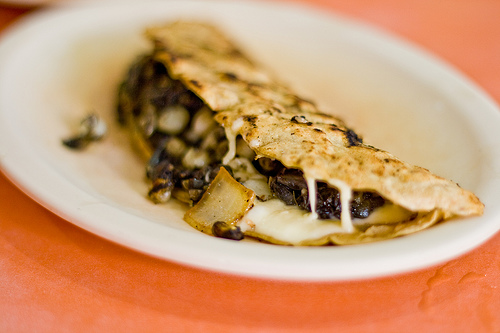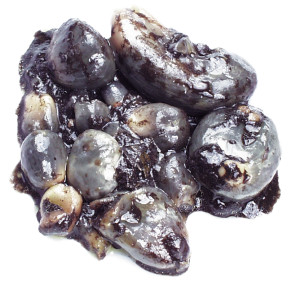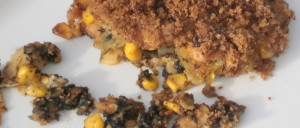Mexican Truffles. Corn Truffles. Corn Smut. Raven Scat. Ustilago maydis gets more unappetizing the further one goes down its list of names. The Aztecs called it huitlacoche. The Mexicans call it a delicacy.
Corn smut is a fungus that grows on young maize. When the corn is in silk kernels become infected. They swell to golf-ball size galls and discolor. Loaded with soluble fiber, the amino acid lysine and the antioxidant anthocyanin, the moist young galls are collected two or three weeks after the corn becomes infected. If not harvested the galls will grow hard and spore-filled looking a smutty dark blue or black. The flavor of young galls is musty, earthy if not smokey. Less expansively they taste like a cross between mushrooms and corn. While the fungus is used like expensive mushrooms and served in elegant restaurants in Latin America it is considered a plant disease in other countries. If you can’t find any fresh locally you can order canned corn smut over the Internet. Perhaps not surprisingly fresh infected corn sells for more than uninfected corn. In the U.S. an ear of huitlacoche costs some 41 cents to produce and sells for about three times that, $1.20. An ear of sweet corn costs about a dime to produce but sells for only a few pennies more.
The Aztecs intentionally inoculated their corn with spores by scratching the base of corn stalk with a soil-smeared knife. In Midwest America hail scratches corn plants allowing spores to enter. The fungus can live up to three years in the soil. The intentional infection is usually manifests itself ten days to two weeks later.

Smut is canned for international sale. A 7 oz. can sells for about $11 plus shipping. Fresh in Mexico it’s about $1.50 a pound, $20 a pound in the U.S.
Though highly nutritious there are reports of toxicity and effects such as fungal skin infection, hair loss and allergic reactions in people. There is little evidence to support that. However when digested Ustilago maydis is known to produce ustizein, guanacine, itaconic acid, ustilagic acid, and the alkaloid ustilagine, which may have similar effects to ergotamine which is from ergot (Claviceps purpurea). Efforts to use corn smut medicinally like ergot has not worked well because it is weaker. See Herb Blurb below. As a fungus corn smut is a distant relative of Boletus and Agaricus mushrooms. Also, out of 1,000 smut species it is one of two commonly eaten. The other is Ustilago esculenta, which grows on rice stalks in China.
Corn smut is widespread. While native to Central America it now has almost worldwide distribution. It is rare, however, in tropical regions and is not found in New Zealand. Corn smut was first noticed in Australia in 1911 but was eradicated around the beginning of World War II. It reappeared in Australia in 1982. It’s common in Europe wherever corn is grown. Corn smut is intentionally grown in limited quantities in California, Georgia, Virginia and in nearby Groveland, Florida. In the United States up to 5% of the corn crop can be unintentionally affected with some species of corn more susceptible than others such as sweet corn. A larger problem is when one infected ear is mechanically harvested the inky spores cover many other good ears picked at the same time making them unusable plus the machine needs to be cleaned. Millions have been spent trying to control it.
As one might expect there are disagreements on what huitlacoche means exactly. While authorities agree huitlacoche (week-la-KOH-chay) comes from the Aztecs there are two or more interpretations which are variations on a theme. Some say it means “sleeping excrement” others “raven excrement.” Regardless, you get the idea. As for the Dead Latin name Ustilago (oos-TILL-ah-go) it means “burnt” because of the way the smut can look as it ages. Maydis (MAY-diss) is the local reference to the corn. Huitlacoche is also written cuitlacoche.
Green Deane’s Itemized Plant Profile: Corn Smut
IDENTIFICATION: Ustilago maydis: Look for large irregular swellings up to 7 inches (20 cm) across on the stems, leaves and ears. Young galls are silvery-white covered by a thin grayish skin. The gall darkens then ruptures exposing a dark brown, powdery spore mass. Spores are rounded and pale brown, densely covered with small pointed spines.
TIME OF YEAR:The local corn-growing season. Rick Bayless, author, chef of Mexican cuisine, owner of Frontera Grill in Chicago says “Pick it when it feels like a pear starting to ripen, when there’s a little give to it. Too firm and it will be bitter. Too late, when the thin skin of the gall breaks if you rub it, and it will taste really muddy.”
ENVIRONMENT: Huitlacoche grows best during times of hot weather in a 78°F to 93°F (25°C–34°C). Prefers nitrogen-rich soil, dry conditions after rain.
METHOD OF PREPARATION: Collected when young and still moist, they are usually cooked like mushrooms. One common simple use is to flavor scrambled eggs. See recipes below.
Smutty Mac and Cheese with a Pecan Crust
Ingredients Pecan Crust
• Half cup (118 ml) butter
• One cup (237 ml) pecans
• One cup (237 ml) panko
Instructions Pecan Crust
• In a small sauté pan melt the butter
• Add the pecans and sauté until the nuts are slightly browned – about 5 minutes
• Strain the nuts, reserve the butter
• When cool mix with panko in a food processor and grind finely
Ingredients Smutty Mac & Cheese
• One cup (237 ml) coarsely chopped huitlacoche
• Quarter cup (60 ml) butter
• Quarter cup (60 ml) flour
• Two cups (or 500 ml) grated old Cheddar cheese
• Two cups ( or 500 ml) grated Gouda
• Two cups ( or 500 ml) grated marbled Cheddar
• Three cups (700 ml) milk
• Bay leaf
• Salt, pepper
• Two cups ( or 500 ml) corn kernels
• 1 sweet onion, diced small
• 3 garlic cloves, chopped
• 13 ounces (341 g) pasta, macaroni type
Instructions: Remove the smut off the cob.Coarsely chop the huitlacoche. Cook pasta, reserve. In a large sauté pan use the reserved butter and heat until it bubbles. Add the flour, stir until the roux darkens. Add milk, bay leaf, salt and pepper, simmer for 10 minutes. Fold in cheeses, stir until melted. Add corn kernels. Caramelize onion and garlic, add to cheese mixture. Fold in pasta. Butter a baking dish. Spread half the mixture in bottom layer. Spread the huitlacoche on top. Add the rest of the mixture, concealing the smut. Top with the pecan mixture. Bake at 350 F. for 1/2 hour or until bubbly and the crust is browned.
Huitlacoche Soup
Recipe from Ellen and Tom Duffy
In damp weather corn frequently becomes infected with corn smut–Ustilago maydis–which when fresh occurs as pearly gray globules and ovoids displacing the rows of kernels. They should not be used when old and dried and powdery. At this time the black interior is widely exposed and the gleaming surface gone. It may cause uterine contractions in pregnant women when old and decayed. It is considered a great delicacy in parts of Mexico and here is a soup we have developed. It is delicious with a slight gray color. (There are black spores in the fresh globules also.)
A.
- 1-1/2 cups (354 ml) milk
- 3 Tablespoons (44 ml) flour
- 3 Tablespoons (44 ml) butter
- 2 Tablespoons (30 ml) Worcestershire sauce
- 4-6 drops Tabasco sauce
B.
- 1 cup of huitlacoche (or slightly more)
- 1 small yellow onion
- 1 clove garlic
- 2 Tablespoons (30 ml) bland oil or margarine or ghee
- 1 cup (354 ml) chicken broth
Whirl together all ingredients in group “A” in a blender or food processor until mixed. Cook slowly, stirring until white sauce thickens. Chop finely all solid ingredients in group “B” and sauté until tender–add the huitlacoche last as it cooks a little quicker. Whirl in blender or food processor with the chicken broth, add to the cream sauce, heat and enjoy.
Herb Blurb
Ustilago maydis, a new fungal model system for cell biology.
Source
Max Planck-Institut für Terrestrische Mikrobiologie, Karl-von-Frisch-Str., D-35037 Marburg, Germany; School of Bioscience, University of Exeter, Stocker Road, Exeter, EX4 4QD, UK. G.Steinberg@exeter.ac.u
Abstract
The use of fungal model systems, such as Saccharomyces cerevisisae and Schizosaccharomyces pombe, has contributed enormously to our understanding of essential cellular processes in animals. Here, we introduce the corn smut fungus Ustilago maydis as a new model organism for studying cell biological processes. Genome-wide analysis demonstrates that U. maydis is more closely related to humans than to budding yeast, and numerous proteins are shared only by U. maydis and Homo sapiens. Growing evidence suggests that basic principles of long-distance transport, mitosis and motor-based microtubule organization are conserved between U. maydis and humans. The fungus U. maydis, therefore, offers a unique system for the study of certain mammalian processes.
[PubMed
Huitlacoche (Ustilago maydis) as a food source–biology, composition, and production.
Source
Centro de Investigación y de Estudios Avanzados del IPN, Departamento de Biotecnología y Bioquímica, Gto., México.
Abstract
Huitlacoche is the ethnic name applied to the young fruiting bodies (galls) of the fungus Ustilago maydis, which causes common smut of maize (Zea mays L). Biologists and agronomists have historically used U. maydis as a model to study a wide array of genetic, physiological, ecological, and phytopathological phenomena. In Mexico and other Latin American countries, huitlacoche has been used traditionally as human food, being highly regarded as an interesting dish or condiment. The food potential of huitlacoche is described here in terms of its chemical composition, which includes carbohydrates, proteins, fats, vitamins, and minerals. In addition, essential amino acids (especially lysine) and fatty acids (linoleate) are present in huitlacoche in considerable levels, adding to its nutritional attributes. The feasibility of growing U. maydis in submerged agitated culture has yielded a variety of fermentation products, including essential amino acids, proteins, vitamins, and flavorings, among others. Recent interest in developing huitlacoche as a cash crop has come from increasing acceptance by the North American public, who prize it as a new delicacy. However, research efforts are still needed to determine the biological factors involved in the establishment of U. maydis as a pathogen on the maize plant. This review deals with the role of huitlacoche as a food source, implicating the biological components that will determine the development of technologies for large scale production.
PubMed
Farming Fungus In Florida
By the Organizations of American States
FORTY-NINE-YEAR-OLD Roy Burns of Burns Farms Huitlacoche, Groveland, Florida, has something growing in his field that most farmers dread the sight of–corn fungus. In the last six years Burns has almost cornered the U.S. market for this latest ethnic food fad known by its Latin taxonym, ustilago maydis, but more commonly by its Nahuatl name, huitlacoche.
While other farmers fear outbreaks of the crop-killing plague they curse as “corn smut,” Burns hopes to get rich off it. “People think I’m crazy for trying to grow this stuff on purpose,” he says. “But one of these days I’ll get it right and then I’ll be the huitlacoche king.”
Huitlacoche is a delicacy in Mexican cooking, but its availability in the market is an unforeseen accident of the growing season. Rain, temperature, and wind all play a role in making the fungus break out in any given field at any given time. If an outbreak does occur, a farmer in Mexico might lose his corn but can sell his huitlacoche to any number of buyers.
It is not so simple in the U.S., however, where huitlacoche is not as well known as, say, mushrooms–still every bit the fungus as the Mexican variety. But Mexican chefs, cookbook authors, and restaurants north of the border call increasingly for this hard-to-find ingredient. It has even found its way onto menus of many non-Mexican eateries as an exotic garnish. Legend has it that Emperor Maximilian rolled huitlacoche in his crepes, turning it overnight into a rare French treat.
Josefina Howard, owner of New York City’s Rosa Mexicana restaurant on the tony East Side, has done more than anyone to popularize huitlacoche in the U.S., serving up about one hundred pounds a week. “Huitlacoche has a wonderful earthy corn taste–and cooks into the most elegant black color,” she says. “It’s so adaptable, it can go in anything–soup, sauce, ice cream, you name it.”
The Burns farm is located in Florida’s citrus belt within sight of DisneyWorld, but Burns is completely on his own when it comes to growing huitlacoche. He and his brother have been experimenting hit-or-miss to mix and apply fungus spores to individual ears of corn in order to produce a big crop at the right time.
“Our county extension agent doesn’t know the first thing about growing a crop fungus,” says Burns. “All he cares about is eradicating it. And no one on the agricultural trade board will give me the time of day. They all think I’m nuts to be trying to sell corn smut.”
Burns sold almost seven thousand pounds last year, grown on just seven acres of corn. With demand soaring and he the only grower, he plans to push the price past ten dollars per pound on his next crop. That comes to a nifty profit per acre.
But growing huitlacoche presents plenty of pitfalls. El Nino’s torrential rains wiped out all his winter corn, and with it his fungus crop. Timing the harvest is also critical. Picking by hand, ear by ear, requires strict crew control. Getting into the field just a day late means losing this highly perishable crop.
Marketing too can be a problem. If he can’t supply customers in a timely fashion, they threaten to switch to a canned Mexican product, albeit with a far inferior taste. For this reason alone, Burns has many chefs rooting for his success. This year he plans to harvest his summer crop through July and hopes to have enough in the freezer to last until the winter crop comes in October.








